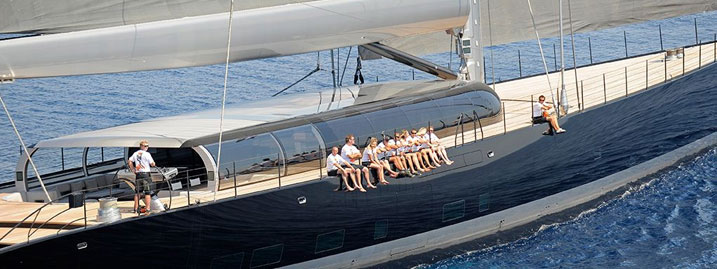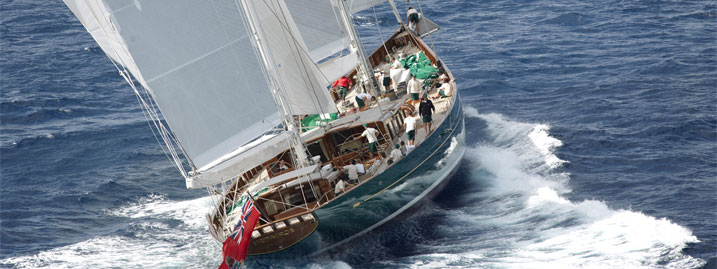If taller and bigger is better, then this yacht, with its spectacular sail-art, has it all!

9. Aglaia (now named Ahimsa) – 217ft – launched 2011
Built by the Dutch shipyard, Vitters and designed by Dubois Naval Architects. Maximum speed 18 knots. Built of aluminium.
Originally named after the Greek goddess of beauty and splendour, the Aglaia was the largest Vitters to date, her design breaking new ground in several areas. The designers were quoted as saying, “Aglaia is the confirmation that it’s kind of fun to do the impossible”.
She boasted the tallest, most advanced sloop rig, measuring more than 80 metres above her deck and a massive composite rudder, built by Green Marine, one of the largest ever made. Her sail area had a displacement ratio equivalent to a racing yacht and the design team set themselves a target of hoisting the main sail in less than 2 minutes and tacking the boat within 30 seconds. The carbon mast was the largest ever produced by Southern Spars and had to be transported in 2 sections. Her enviable racing performance was due to her powerful rig, long waterline length, light weight and lifting keel, providing exceptional upwind pointing and speed. Even so, the project was shrouded in secrecy by her owner and little more is known about this spectacular yacht.
Aglaia’s second season started with some extraordinary artwork on her massive sails, by the Norwegian artist Magne Furuholmen. It is one of the world’s largest paintings on canvas and includes letters from the names of the owner’s family.
In 2014 a refit and name change to Ahimsa, pointed to the probability that the boat had been sold, no further details are known about the boat or the new owners.

8. Hetairos - 219ft – launched 2011
Built by Baltic Yachts of Finland and designed by Reichel Pugh Yacht Design in collaboration with Dykstra & Partners. Maximum speed 20 knots. Accomodation for 10 crew and 10 guests. The largest and fastest superyacht capable of navigating the Panama Canal and the largest to have been built from carbon-fibre composite.
The initial brief was to have a yacht which could not only make long crossings and race fast, be capable of cruising and entering shallow bays and anchorages, but also to retain a historical link by giving her classic looks. In order to be capable of transitting the Panama Canal, the design team had to limit her mast height, so they started with a maximum rig plan as a ketch with a 62.5 metre air draught and developed it into the lines of a pilot cutter, giving the longest waterline length and the highest speed potential. The finished result is a modern, fast carbon built yacht with the feel of a 20th century racing yacht.
Hetairos’s construction is an extraordinary achievement of innovation and originality. The heart of the propulsion system is the twin retractable thrusters, the keel and rudder are fitted with a lifting mechanism and there are three unique under-deck furlers for the yacht. In contrast to this is the interior design, built on the three stage story that she was originally a commercial boat, fitted out as a yacht, but having had an Oriental refit. The result gives the initial impression of something built 100 years ago, with the use of different varieties of wood suggesting the developing history of the vessel. Stained cherry wood was used in some areas and teak and limed ash in others. The stained walnut floor planks were cut not quite straight and included false repairs and butterfly joints, with the impression of a century of accumulated dirt being achieved by mixing grit with epoxy resin between the planks. The furniture was designed to look old by destressing it with chains and dirt before varnishing, with the white paint on the deckhead being applied over a darker undercoat. The finished result was a creation of a 100 year old coaster-cum-luxury yacht; not really “shabby chic”, rather “historical chic”.
Does this mismatch work? Well – at the end of her first serious voyage Hetairos crossed the finish line in Virgin Gorda, British Virgin Islands, on 30th November 2011, in the Transatlantic Superyacht Regatta and Maxi Yacht Cup after a 3,000 mile crossing and a passage time of 8 days, 58 minutes and 30 seconds, averaging 15.12 knots. Her top recorded speed on the journey was 25.7 knots. Sounds like a success story to me!

Author - Dee White